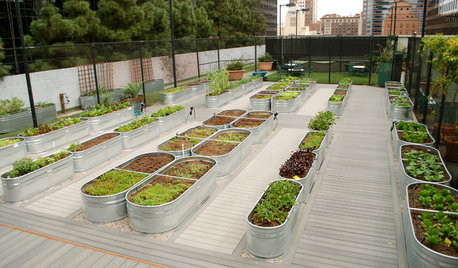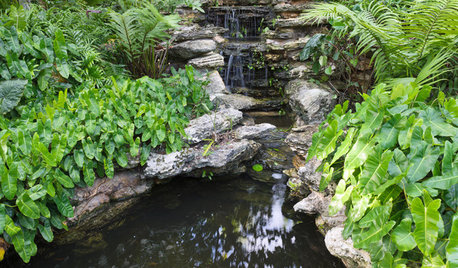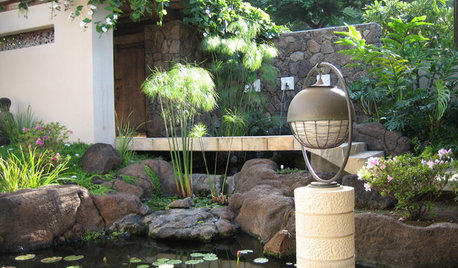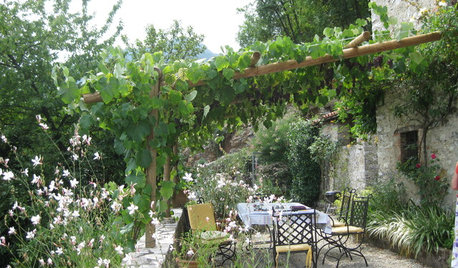need a 'soil recipe' for container gardening
kawaiineko_gardener
14 years ago
Related Stories

CONTAINER GARDENSContainer Gardening Basics: The Dirt on Soil
Learn the types of potting soil available and the best mixes to help your containers thrive
Full Story
LANDSCAPE DESIGNRecipe for Modernist Edible Garden Style
Herbs, vegetables and fruit trees aren’t just for traditional gardens. Here’s how to design them into modernist landscapes
Full Story
LANDSCAPE DESIGNRecipe for Tropical Edible Garden Style
Appeal to exotic good taste with fruit trees, palms and tropical look-alikes in your temperate-climate garden
Full Story
LANDSCAPE DESIGNRecipe for Asian Edible Garden Style
A surprising number of food plants are hiding out in Asian-themed landscapes. Add a few more and extend the Zen flavor to the kitchen
Full Story
LANDSCAPE DESIGNRecipe for Mediterranean Edible Garden Style
The only thing better than a delicious meal outdoors is the satisfaction of growing some of the key ingredients yourself
Full Story
FARM YOUR YARDHow to Grow Vegetables in Containers
Get glorious vegetables and fruits on your patio with a pro’s guidance — including his personal recipe for potting mix
Full Story
GARDENING GUIDESGet the Dirt on Your Garden’s Soil
Understand how your soil supports your plants so you can ensure your garden’s success
Full Story
GARDENING GUIDESGreat Design Plant: Try Blue Bells for Blooms in Dry Soil
This shrub’s violet-blue flowers and silvery foliage brighten low-water gardens all year long
Full Story
GARDENING GUIDESGrow a Beautiful Garden in Alkaline Soil
Got alkaline soil? Learn how to manage it and the many beautiful plants that will thrive in this ‘sweet’ soil
Full Story
FARM YOUR YARDHow to Get Good Soil for Your Edible Garden
The nutrients in your soil feed the plants that feed you. Here are tips on getting it right — just in time for planting season
Full Story




kawaiineko_gardenerOriginal Author
gardengal48 (PNW Z8/9)
Related Discussions
Year 2 Newbie Container Gardener- Need help with potting soil mix
Q
Container soils and water in containers (cont.)
Q
Good garden soil makes poor soil for roses in containers?
Q
container newbie needs input for soil/container mix
Q
wordwiz
badsmerf
tapla (mid-Michigan, USDA z5b-6a)
kawaiineko_gardenerOriginal Author
tapla (mid-Michigan, USDA z5b-6a)
Jesusbeloved29_yahoo_com
kawaiineko_gardenerOriginal Author
tapla (mid-Michigan, USDA z5b-6a)
sissysimone
kawaiineko_gardenerOriginal Author
gardengal48 (PNW Z8/9)
tapla (mid-Michigan, USDA z5b-6a)
wordwiz
tapla (mid-Michigan, USDA z5b-6a)
wordwiz
jojosplants
wordwiz
jojosplants
wordwiz
tapla (mid-Michigan, USDA z5b-6a)
tapla (mid-Michigan, USDA z5b-6a)
jojosplants
tapla (mid-Michigan, USDA z5b-6a)
wordwiz
jojosplants
tapla (mid-Michigan, USDA z5b-6a)
jojosplants
meyermike_1micha
tapla (mid-Michigan, USDA z5b-6a)
jojosplants
wordwiz
briergardener_gw
tapla (mid-Michigan, USDA z5b-6a)
wordwiz
kawaiineko_gardenerOriginal Author
badsmerf
tapla (mid-Michigan, USDA z5b-6a)
jojosplants
jojosplants
gardengal48 (PNW Z8/9)
wordwiz
topie
tapla (mid-Michigan, USDA z5b-6a)
rnewste
topie
kawaiineko_gardenerOriginal Author
digdirt2
digdirt2